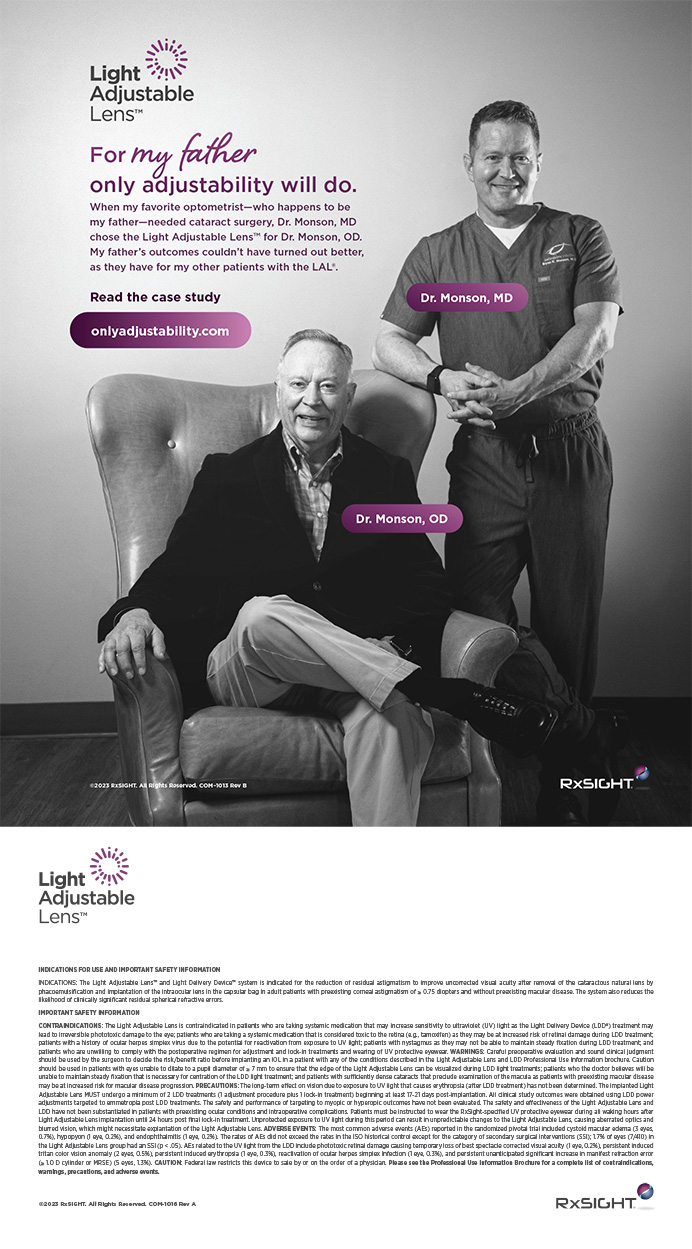The debate about the optimum thickness of a LASIK flap or whether an Epi-LASIK/PRK approach is best really has seemed endless, but I think the situation is about to change. I believe the best option for our refractive surgery patients is the creation of a customized, sub-Bowman's flap. In my opinion, the most consistent and safest method for making this flap uses a femtosecond laser.1
REMOVING CORNEAL TISSUE
The debate about the appropriate thickness of a LASIK flap has much to do with our growing fear about causing postoperative ectasia. We are all aware that there is a limit to how much corneal tissue can be removed without the risk of producing a negative postoperative response. Concerns about ectasia have motivated many of us to perform PRK or Epi-LASIK.
CORNEAL THICKNESS AND STRENGTH
Professor John Marshall and his group at King's College in London have compared the relative strength of the cornea following PRK, Epi-LASIK, and thin-flap LASIK or sub-Bowman's keratomileusis (SBK). They concluded that, with a femtosecond LASIK flap of 80 or 90µm, the biomechanics of the SBK corneas are indistinguishable compared to surface ablation and do not damage the epithelium.2
A sub-Bowman's flap requires a consistent thickness across its entirety in order to avoid buttonholes or perforations. In my practice, all SBK flaps are designed with the Intralase laser (Intralase Corp., Irvine, CA) to be 90µm across the entire diameter. I am able to achieve a very consistent thickness across the flap with very small standard deviations in thickness (Figure 1).
Consistent flap thickness is important to consider, not only because of the relative strength it provides, but also because of the associated visual outcomes. Mechanical microkeratomes create flaps that are thicker in the periphery than the center, whereas the Intralase laser produces a flap that has relatively the same thickness across its diameter.
CUSTOMIZED SUB-BOWMAN'S FLAPS
The advantages to using sub-Bowman's flaps include fewer cut nerves; a trend toward improved visual outcomes, particularly with customized LASIK; less required time for creation; a reduced occurrence of post-LASIK dry eye; and less risk of lost suction.
My goal is to create a flap of less than 80µm with a diameter that is between 1.0 to 1.5mm outside of the ablation zone. I have three excimer lasers in my ORs: a Ladarvision 4000 (Alcon Laboratories, Inc., Fort Worth, TX); a Ladar 6000 (Alcon Laboratories, Inc.); and a Technolas 217 (Bausch & Lomb, Rochester, NY). If I am using either Alcon laser, the maximum ablation zone is 6.0mm, so the flap diameter is set for 7.0 to 7.5mm. With the Technolas, the flap size will be between 7.5 and 8.0mm for a 6.0-mm ablation zone. I do not believe that the flap needs to be any wider, and my patients have not experienced any glare or halos since I adopted this approach.
The great advantage of the Intralase laser is that I can program it to customize the flap according to the diameter of the ablation, the flap's thickness according to the surgical plan, and even the preexisting astigmatism to create a flap that matches the pattern. I can also program the laser to produce a flap with a notched or beveled edge to add more surface healing area and strengthen the flap.
My colleagues and I are currently involved in a clinical study with Daniel Durrie, MD, of Overland Park, Kansas, to compare the clinical results and visual outcomes of thin flaps produced with a femtosecond laser versus PRK. The study is contralateral and involves 50 patients who will undergo PRK in one eye and LASIK with the Intralase laser in their contralateral eye. We plan on reporting our results later this year.
In conclusion, SBK may provide the early visual recovery, comfort, and wow factor of LASIK along with what we as refractive surgeons perceive as safe surface ablation. Safety is first, but, if the safer surgery also provides happier patients, then that surgery certainly holds promise for me.
Stephen G. Slade, MD, is Medical Director of Slade & Baker Vision Center in Houston. He is a consultant for Alcon Laboratories, Inc., Bausch & Lomb, and Intralase Corp. Dr. Slade may be reached at (713) 626-5544; sgs@visiontexas.com.


